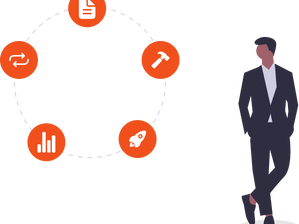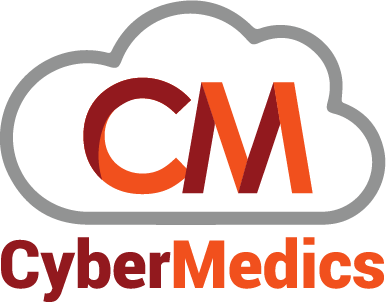
5 Software Development Life Cycle Methodologies: A Guide
Software development is an ever-evolving process, and it’s important for companies to be aware of the different software development methodologies available.
Each methodology has its own set of advantages and disadvantages that must be considered when deciding which approach works best for a given project.
At CyberMedics, we’ll explore five popular SDLC (Software Development Life Cycle) methodologies and understand the strengths and weaknesses of each software development process so you can make an informed decision on how to approach your next software project without sacrificing quality or productivity.
1. The Agile Methodology
The Agile SDLC methodology is an iterative approach to software development that emphasizes flexibility, collaboration, and communication. Instead of following a rigid plan, the agile method encourages teams to adapt to change and make adjustments along the entire development process.
This means that teams are encouraged to collaborate closely with customers during the software development lifecycle to ensure their expectations are met. As a customer’s needs and requirements evolve, the development team can be more responsive in addressing them.
Source: Great Learning
Pros:
Flexibility: adaptable to changing development environments, requirements, and teams
Embracing uncertainty means you’re open to discovery and new solutions
Immediate feedback through cyclical development and testing, leading to a finished product
Customer focus: prioritizes tasks that matter and solves problems optimally
Overall less defective products: efficient and robust end product due to development, implementation, testing, feedback and debugging.
Cons
Lack of documentation: ever-changing scope of the project makes documentation obsolete
Scope creep: customers and other team members may demand more and more leading to mismanagement
Time: cycle of definition, development, testing, feedback, and refactoring is time-consuming and requires resources
Availability: members need to be available almost always, leaving little time for other commitments
Lack of predictability: the ambiguity of the future can be stressful and cause entities to opt out at crucial stages.
When should you use the agile methodology?
Agile works well for developing software projects that are uncertain or have a high degree of complexity. It’s also a good fit for teams that value collaboration, creativity, and continuous improvement. If you have a project and team that fits the bill, give agile a shot!
2. The Waterfall Methodology
The waterfall methodology is a traditional, linear approach to software development that follows a sequential path from concept to implementation. It was created with the intention of streamlining the process and ensuring projects remain focused and on track.
Source: Adobe Experience Cloud
Under this method, software development teams move through each step one at a time in order:
Gathering and defining project requirements with clear and detailed specifications.
Creating a detailed design plan for the product, including architecture and system design.
Developing and coding the product, as per the design specifications.
Conduct thorough testing of the product to ensure its functionality and quality.
Maintaining the product and providing support for its users after the product has been delivered and implemented.
Pros
Clear and Defined Plan: each phase of development is clearly outlined in advance
Easy Tracking: progress can be monitored at each stage, and any problems identified quickly
Predictable Timeline: teams know how much time they have to complete each phase
Easy Documentation: the sequential nature of the method makes it easier to document progress
Cons
Inflexible: not adaptable in case of sudden changes or customer feedback
No room for iteration: issues may be identified too late in the process, leading to costly fixes
Time and cost: linear nature of the process means there is no room for improvement, leading to higher costs and longer development time.
When should you use the waterfall model?
The waterfall approach works best for project teams with a predictable timeline, clear requirements, and well-defined scope. This method is particularly useful when working with inexperienced or new teams since it provides a structure to help them stay on track.
3. The Spiral Model
The spiral model combines the best of both the waterfall and agile approaches, offering a framework for managing risk while embracing change. It’s an iterative model that involves four phases, and each iteration of the spiral model results in a more complete and refined version of the software, while also taking into consideration any potential risks that may arise during the development process.
Planning: identify goals, resources, and constraints
Risk Analysis: evaluate risks and strategies for mitigating them
Engineering: design, develop, and test the software
Evaluation: review progress and re-evaluate objectives
Source: Wikipedia
Pros
Addresses risks head-on: The Spiral Methodology takes a proactive approach to risk management, so potential problems can be identified and addressed early on in the process.
Improves with each iteration: the software being developed gets better and better with each cycle, as refinements are made.
Customer-centric: There’s a strong emphasis on involving the customer in the process, which helps ensure the final product meets their needs and expectations.
Flexible to change: Because the Spiral Methodology is designed to adapt to change, it’s a great choice for complex and ever-evolving projects.
Cons
Takes time: The Spiral Methodology can be a time-intensive process, as each iteration includes a full cycle of planning, risk analysis, engineering, and evaluation.
Resource-heavy: requires a lot of resources for planning, testing, and documentation.
Can be complicated: The Spiral Methodology is more intricate compared to other software development life cycle (SDLC) options – you must strictly adhere to protocols to ensure efficient operation. Additionally, the model’s intermediate phases necessitate an increased level of documentation.
May lack focus on deliverables: Going into a project, it can be difficult to predict the number of phases required, making it challenging to manage the timeline and budget effectively. There is always a risk of falling behind schedule or exceeding the budget.
When should you use the spiral methodology?
The Spiral Methodology is ideal for a software development project that has a high degree of risk and uncertainty, like if there’s new tech involved. It can accommodate changes or revisions, even late in the process.
The Spiral model also works well for large-scale projects that require ongoing customer input and feedback throughout the development cycle.
4. Lean Development
The Lean Development approach is based on the principles of lean manufacturing, with a focus on eliminating waste and maximizing efficiency. Its core values are speed, agility and customer-centricity.
👉 Related: 7 Deadly Wastes of Lean Software Development (+ The Fixes)
The process typically follows five steps:
Identifying value: Determine what customers value and need, e.g. software company conducts market research to find the most important features for their target audience.
Mapping the value stream: Map out all processes to identify inefficiencies and waste, e.g. manufacturer analyzes the production process to streamline steps.
Creating flow: Eliminate waste and optimize processes, e.g. software development team implements agile methodologies to reduce iteration time and increase delivery speed.
Establishing pull: Balance supply with customer demand by only producing what is needed, e.g. clothing manufacturer implements just-in-time production.
Seeking perfection: Continuously improve the process, e.g. software development team conducts regular retrospectives to identify areas for improvement.
Pros
Reduced waste: Lean Development focuses on eliminating waste and improving efficiency, so you can get the most out of your resources.
Agile techniques like Scrum, Kanban, and rapid application development are used to speed up development and ensure quality.
Customer-centric: A customer-first approach is prioritized throughout the process, which helps ensure the final product meets their needs and expectations.
Faster development: The Lean Development approach encourages iterative processes, so teams can quickly refine and deliver products in a shorter amount of time.
Cons
Risk-averse: The focus on reducing waste can lead to an overly risk-averse mentality, which could limit innovation and creativity.
Requires discipline: Lean Development requires teams to have a high degree of discipline, as processes must be followed strictly in order to make the most out of their resources.
When should you use lean development?
Lean Development works best for projects that require agility and speed, such as those involving new or emerging technologies. It’s also useful for products with short development cycles, such as web and mobile applications. Additionally, its customer-centric approach is beneficial for companies that prioritize user experience.
Source: Infinity
For example, we devised tried-and-true lean software methodologies to launch a minimum viable product for Thumbs Up, an organic marketing platform to connect auto dealers with their customer’s network. We focused primarily on features we wanted to test in the market during the development phase.
Another case study: See how we implemented lean product development processes to speed up outdated processes and missed deadlines for Security 101.
5. The V-Shaped Model
While in the waterfall approach, testing phase only happens at the end of a project, the V-Model incorporates testing into every stage of development.
Source: Wikipedia
Think of the V-Model as a series of check-ins along the way. Before moving on to the next stage, the previous stage has to be completed, and a software tester has to sign off on it. The tester is responsible for making sure that the requirements of each phase have been met and that the system is meeting the needs of the user, customer or other stakeholders through both verification and validation.
Pros
Proactive testing: Testing is incorporated into each phase of development, so defects can be identified and addressed before they become bigger issues.
Clear workflow: The V-Model is structured and easy to follow, which helps ensure that requirements are met, and there’s no backlog of work.
Cons
Time-consuming: As testing is done at each stage, this can be quite time-consuming and may lead to delays in the project timeline.
Rigid structure: This methodology requires a lot of documentation and has to be strictly followed, which can limit innovation and flexibility.
When should you use the V-Model?
The V-Model works best for projects that require thorough testing at every stage. It’s especially useful for mission-critical or high-stakes projects, such as those involving life safety systems or medical devices. Additionally, it’s beneficial for short-term projects with a clear timeline and set of requirements.
Pick the right SDLC methodology for your software project with CyberMedics
Choosing the right SDLC methodology for your software project can be a daunting task. With so many models to choose from and their pros and cons, it’s important to think carefully about which one is best suited for your specific needs.
At CyberMedics, we’re all too familiar with handling software development challenges and are here to help you develop quality products quickly and efficiently. Whether you need guidance on choosing between SDLC methodologies or need a hand implementing them, our team of expert developers and project managers are here to help.
Book a FREE consultation today!
